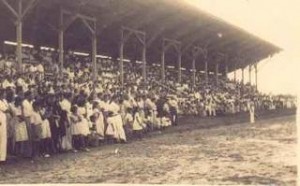Everybody saves keepsakes like pictures, home movies, letters, and other publications for one reason or another, mainly for personal reasons. However, these items are often tucked away in one's attic or left without much opportunity to be shared with others. These items can also potentially serve as historical documentation of a different time and place so that later generations can see what life was like in years past.
This is what is happening in the Peruvian Amazon region and its capital Iquitos, a place where museums are not filled with these types of materials. There are some organizations with its own institutional archives, but bureaucracy and poor management often keeps the items out of view of the general public. Some like the Theological Studies Center of the Amazon [es] (CETA for its initials in Spanish) are doing their part of maintaining a library [es] of historical documents, some of which is available online like this article about Peruvian cinema [es], but still most of this material are located in a physical building in Iquitos. Now through the use of blogs and photo and video-sharing sites, more and more of this material is being shared with others. Some bloggers are uncovering manuscripts for publish on blogs, and others are discovering images and videos of their towns providing a new perspective on how things have changed.
This memory of a city is much more than its mere history. Legends [es] are a big part of this, and the characters [es] that lived in the city. Who was the most popular girl in the 1930s? What was the most well-attended party in the 1940s? Who had the most beautiful house in the era of rubber or petroleum? These are all things that everyone knew back then, but now no one remembers.
For example, the blog Crónicas de Pacarmón [es] is a collection of news and stories about sports written by Don Pablo Carmelo Montalván or better known as “Pacarmon”, who was born in 1906 in X and passed away in 1983. Since 2005, his son Fernando has been publishing these documents on this blog to preserve some of the information and anecdotes from that era including about the inauguration of a new football stadium in 1927 [es].
The author has another blog that is publishing his father's novel about his participation in the Peruvian-Colombian War called: When Country Calls [es].
Home movies from the latter part of the 20th century were not made with uploading them to the internet in mind. However, a recent discovery by Isaac at De La Selva su Web On [es] found a pair of movies taken by a family from San Francisco, California in the mid 1980s of the town of Iquitos. The first one can be seen below and the second part can be seen here.
Video uploaded by Carme001
The daughter, who was 10 years old at the time, decided to upload the videos. In an interview, she writes, “they are historical documents and I thought it was a good idea to share with the world.” Isaac sees these videos as a revelation and as something that can help future generations understand how much or how little things have changed:
Viendo este video me doy cuenta que es importante y debe ser cuantiosa este tipo de registros de nuestras ciudades en manos de los turistas que alguna vez nos visitaron. Todo ese patrimonio o memoria está fuera de nuestro país. Que bueno que internet nos permita repatriar esta información.
There are other blogs with information and interesting stories and old photographs of Iquitos of yesteryear. For example, Raúl Herrera Soria of Amazónico del Perú [es] writes about a train that used to travel the street of Iquitos. There is also information about the mass killing of indigenous during their labor in the rubber industry during the 1910s. Fernando Najar writes:
Décadas después se hizo el recuento de que fueron ejecutados 30 mil witotos y otros 10 mil quedarían flagelados de por vida. Los mataban porque no extraían la cantidad de látex que exigían los administradores de los 42 campamentos caucheros de la Casa Arana y que después se convirtió en The Peruvian Amazon Co. Ltda, registrada en Londres.
Decades later there was the story of the execution of 30,000 witotos (indigenous tribe) with another 10,000 whipped. They were killed because they did not extract the quantity of latex that the administrators of the 42 Casa Arana rubber camps demanded, this later became the Peruvian Amazon Co. Ltd. registered in London.
There are also history posts by Jesuer on Viajeros [es] about the community of Punchana.
Collectively, these documents can help paint a picture of what life was like in the Amazon region and studied for generations to come.








1 comment
1984 Peru
2. Iquitio: http://www.youtube.com/watch?v=x2QOG8x4QXw&feature=channel_page
3. Pisac: http://www.youtube.com/watch?v=C-l_Jw8Ep8Y&feature=channel_page
4. Cusco Machu Pichu:
http://www.youtube.com/watch?v=yNqdOOCjdmE&feature=channel_page
5. Lake Titicaca: http://www.youtube.com/watch?v=O6iLwW6mh30&feature=channel_page